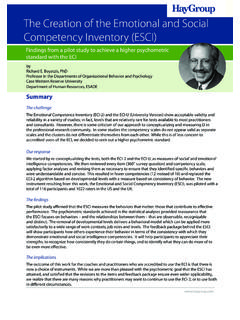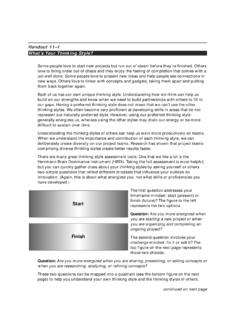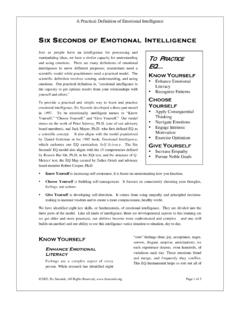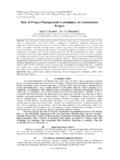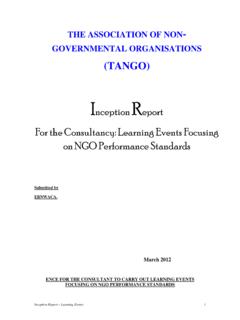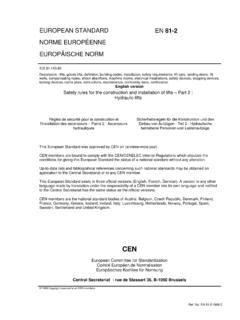Transcription of Consultant Skills - e-russell.com
1 Consultant Skills A summary of the main points of Flawless Consulting by Peter Block. Hugh Russell Goals of consultancy To establish a collaborative relationship. To solve problems so they stay solved. To ensure attention is given to both the Technical/Business problem and the relationships. Developing client commitment during the consulting process People involved Stakeholder: A person affected by the particular issue being addressed by the Consultant . Client: Change sponsor This is the person within the organisation who has the power to oversee/sanction the project undertaken by the Consultant . (NB: This is not always the person who initially calls the Consultant .) Consultant : Change agent This is the person who is trying to have some influence over a group or organisation but has no direct power to make changes or implement programmes.
2 " Change Target: These are the people who may "use" the product/solution provided by the Consultant , the staff who may attend a training event. Stages of consultancy DEFINITION OF consultancy : "A Consultant is a person who is trying to have some influence over a group or organisation but has no direct power to make changes or implement programmes". Source: Flawless consultancy , Peter Block The five phases of any consultancy project are:- 1. Entry and contracting. 2. Data collection and diagnosis 3. Feedback and design for action 4. Action 5. Evaluation and withdrawal THE STEPS INVOLVED ARE 1. Defining the initial problem 2. Deciding to proceed 3. Selecting dimensions to be studied 4. Decide who will be involved 5. Selecting the method (desk research, interviews, questionnaires, group discussion) 6.
3 Data collection 7. Funnelling the data 8. Data Summary 9. Data Analysis 10. Feedback of results 11. Making recommendations 12. Decisions on actions Stage 1 Entry and Contracting First Contact with Client Telephone questions before the first meeting, to be put by Consultant to client:- What do you want to discuss? Who is the client for the project? Who else will be attending meeting? How much time will we have? Do you know that you want to begin some project or are we going to discuss possibilities? Plan the Contracting Meeting: Have clear objectives for the meeting and communicate these to the person you are seeing. Research the organisation of the client before first meeting. Consider how you will judge whether or not you can help the client, what other commitments do you currently have.
4 Entry and Contracting Meeting: The purpose of entry is to establish rapport and credibility, build trust and confidence, develop common ground and deal with anxiety on the part of the client. Key Areas to Cover with Client: Definition of the problem. Reasons why problem needs to be addressed (watch for hidden agenda). Criteria that any outcome must satisfy - what is desired state client is aiming form. Limits of client authority/power. Clients expectations of you - what role do they expect you to fulfil? Consultant or surrogate manager. Level of support you require from client. Extent of confidentiality. Resource constraints - deadlines; budgets; access to stakeholders; release from job if training need identified.
5 End by summarising what has been agreed. Be prepared to go back and re-contract if your diagnosis with stakeholder reveals that your original contract was inappropriate. During meeting watch for signs of the client s motivation for project; does client feel coerced or threatened by loss of control? Contract Formulation: Following interview write a letter stating explicitly what was agreed between yourself and client and covering the following elements:- 1. The boundaries of your analysis. 2. Objectives of the project. 3. The kind of information you seek. 4. Your role in the project. 5. The product you will deliver. 6. What support and involvement you need from your client. 7. Time schedule and costs. 8. Confidentiality acknowledgement.
6 9. Method of evaluation and feedback. Ground Rules for Contracting 1. Responsibility for every relationship is 50/50. 2. Contract freely entered into. 3. You can't get something for nothing. There must be consideration from both sides. 4. All wants are legitimate. 5. You can say no. 6. You don't always get what you want. 7. You can contract for behaviour; you can't contract for the other person to change their feelings. 8. You can't promise something you don't have. 9. You can't contract with someone not in the room. 10. Write down contracts. 11. Contracts are re-negotiable. 12. Contracts require time deadlines Stage 2 Data Collection and Diagnosis The purpose of data collection and diagnosis is to gather information from client and stakeholders in a non-judgemental and objective way.
7 Your goal is to develop a clear and simple picture of what is causing and maintaining the client s problem, including a description of the business problem the client has asked for help on and a description of how the problem is being managed. The steps in data collection and diagnosis are:- 1. Identifying the presenting problem. 2. Making the decision to proceed. 3. Selecting the dimensions of enquiry. 4. Deciding who will be involved. 5. Selecting the data collection method. 6. Collecting data. 7. Funnelling the data. 8. Data summary. 9. Data analysis. Additional Points to Note: As a Consultant you must, at this stage, be able to:- 1. Distinguish between the presenting problem and the underlying problem. 2. Elicit and describe both the business problem and how the problem is being managed.
8 3. Ask questions about the clients own personal role in causing or maintaining the presenting or target problem. 4. Ask questions about what others in the organisation are doing to cause or maintain the presenting or target problem. Stage 3 - Feedback and Design for Action Presenting Findings, Conclusions and Recommendations to a Client: When you undertake diagnostic work you often discover information not known to the client. As this new information may throw a different light on the situation; it is important to meet with the client once the diagnosis and analysis is complete. The Purpose of the Meeting is to: Inform the client of the findings from the diagnosis and the conclusions you have drawn from them. Present broad recommendations/options for taking the work forward.
9 Obtain the clients reactions to the work done. Review the original contract and agree a contract for the next stage of the work (where appropriate). This meeting sometimes proves to be the most difficult part of the process. The information collected may reflect badly on the client or may contradict the client's own beliefs about the situation. Presenting this data requires you to achieve a delicate balance between sensitivity and directness. To help make the Meeting a Success: Link this meeting with the previous action by reminding the client of the original contract and outlining the work done so far. Have an agenda/structure for the meeting and agree this with the client. Tell the client what you want to achieve by the end of this meeting.
10 Prepare the client for any "surprises" by informing her/him that the findings contain new information. Report back the positive things discovered as well as the problems. Cover the expected before the unexpected. This allows the client to absorb and accept the straightforward information before hearing the things likely to prompt an emotional reaction. Be prepared not to go beyond the boundaries of the initial contract. If you do have recommendations which go beyond these boundaries, prepare the client first. Accept that he/she may not wish to take these forward. Outline all the issues in full so that the client understands the basis for any recommendations made. Trying to avoid an emotional reaction, by skirting around issues and hoping the client reads between the lines, will cause confusion.


